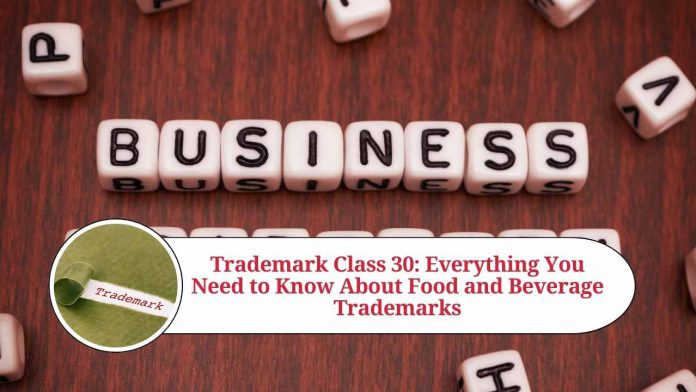Trademark Class 30: An Overview
Trademark classes are categories of goods and services that are registered under the Trademark Act. These classes are organized according to the nature of the goods or services being offered by a business. One such class is Class 30, which covers a wide range of food and beverage products. In this blog post, we will discuss the specifics of Class 30 and the types of products that fall under it.
Goods Covered under Class 30
Class 30 covers a broad range of food and beverage products, including but not limited to:
- Coffee, tea, cocoa, and artificial coffee;
- Rice, pasta, and noodles;
- Bread, pastries, and confectionery;
- Spices, seasonings, and condiments;
- Honey, syrup, and molasses;
- Salt, baking soda, and yeast;
- Ice cream, sorbets, and frozen yogurts;
- Snacks, chips, and crackers;
- Sauces, dressings, and marinades;
- Cereals, muesli, and granola.
Examples of Class 30 Trademarks
Here are some examples of well-known trademarks that fall under Class 30:
- Nescafe – a brand of instant coffee
- Cadbury – a brand of confectionery
- Coca-Cola – a brand of carbonated soft drinks
- Oreo – a brand of cookies
- Nutella – a brand of hazelnut chocolate spread
- Kellogg’s – a brand of breakfast cereals
- Hershey’s – a brand of chocolate and candy
- Heinz – a brand of ketchup and condiments
Why Trademark Registration is Important for Class 30 Goods
Trademark registration is essential for any business that sells food and beverage products. Registering your trademark under Class 30 provides legal protection against infringement by competitors. It also gives your business exclusive rights to use the trademark for the goods and services covered by the registration.
Moreover, registering your trademark in Class 30 helps establish your brand identity and build trust with customers. Customers are more likely to purchase products from a brand they recognize and trust.
Class 30 is a popular trademark class, especially for businesses operating in the food and beverage industry. This is because it covers a diverse range of products that are consumed by people on a daily basis. From breakfast cereals to snacks, and from sauces to spices, there is a wide variety of goods that fall under this class.
One of the key benefits of registering a trademark under Class 30 is that it provides exclusivity over the use of that trademark for the specific goods covered by the registration. This means that other businesses cannot use the same or a similar trademark for similar goods. In case of infringement, the owner of the registered trademark can take legal action against the infringing party and protect their intellectual property rights.
Moreover, registering a trademark in Class 30 can help businesses create brand recognition and loyalty. A well-known trademark can become synonymous with the products it represents, leading to customer loyalty and repeat business. A strong brand identity can also help businesses expand their product offerings and enter new markets.
When applying for a trademark registration under Class 30, it is important to provide a detailed description of the goods and services that the trademark will cover. This will help the trademark office to determine whether the trademark is eligible for registration and to identify any potential conflicts with existing trademarks.
Conclusion
In conclusion, Class 30 is a crucial trademark class for businesses operating in the food and beverage industry. Registering a trademark under this class provides legal protection, creates brand recognition, and builds customer trust. If you are operating in this industry, it is important to consider registering your trademark under Class 30 to protect your intellectual property rights and establish your brand in the market.
Read more useful content:
Frequently Asked Questions (FAQs)
What is Trademark Class 30?
Trademark Class 30 is a category of goods that includes food and beverage products such as coffee, tea, pasta, confectionery, snacks, sauces, and spices.
What types of products are covered under Class 30?
Class 30 covers a wide variety of food and beverage products, including but not limited to coffee, tea, cocoa, pasta, bread, pastries, confectionery, spices, seasonings, honey, syrup, molasses, salt, baking soda, yeast, ice cream, sorbets, frozen yogurts, snacks, chips, crackers, sauces, dressings, marinades, cereals, muesli, and granola.
Why is it important to register a trademark under Class 30?
Registering a trademark under Class 30 provides legal protection against infringement by competitors and helps establish your brand identity and customer trust.
Can I register a trademark under multiple classes?
Yes, you can register a trademark under multiple classes if your business offers goods or services that fall under different categories.
How long does it take to register a trademark in Class 30?
The time it takes to register a trademark in Class 30 varies depending on the jurisdiction, but it typically takes anywhere from 6 months to 2 years.
How long does a trademark registration last in Class 30?
A trademark registration in Class 30 usually lasts for 10 years, after which it can be renewed for further 10-year periods.
Can I trademark a generic term in Class 30?
It is difficult to trademark a generic term in Class 30 as it is unlikely to be distinctive. However, it may be possible to trademark a generic term if it has acquired a secondary meaning in the market.
Can I use a trademark that is registered in Class 30 for other products?
No, a registered trademark can only be used for the specific goods or services covered by the registration.
Can I register a trademark under Class 30 for an untested food or beverage product?
No, a trademark cannot be registered for a product that has not been introduced in the market or is still in development.
How can I search for existing trademarks in Class 30?
You can search for existing trademarks in Class 30 by using the trademark search database of the relevant trademark office or by hiring a trademark attorney to conduct a comprehensive search for you.




















